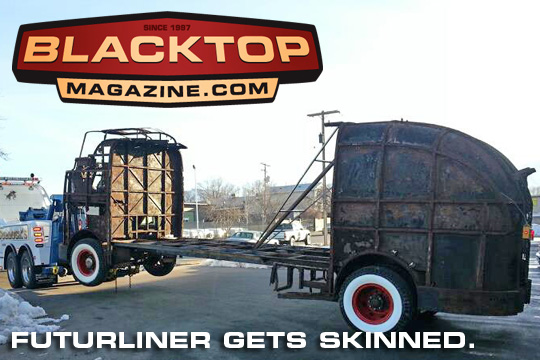Kindig-It Design Uses Todays Technology to Bring Futurliner to Life

Photos provided by Kindig-It Design, Story: Sherri Candland
Dave Kindig and his crew at Kindig-It Design knew they were in for a very time consuming project with the 1939 GM Parade of Progress Futurliner. The sheer size of the project is daunting, requiring Kindig-It Design to employ an entire team just for that build. The biggest issue however, has been the fact that there were only 12 ever in existence, so all parts have to be fabricated by the Futurliner restoration team. Ryan DeCol, project manager over the massive Futurliner says “we are literally just taking this one day at a time, and truly rebuilding it one piece at a time.”
The project also has the eyes of the world watching to see how accurately Kindig-It Design can bring the Furturliner back to her glory, while preserving an incredible piece of automotive history. Because of this, Kindig-It Design opted to employ a local company to digitally scan each piece of the Futurliner before tearing into her. Meshwerks, a Salt Lake City based company has been doing work like this for over 13 years. They use their equipment, to literally create a digital reference manual, which can be referred to at any time during the restoration. This type of reverse engineering has been widely used in the military world for years. Using Cad, or computer-aided design, a structure or objects function and operation can be fully analyzed.
Kevin Schiedle, founder of Meshwerks, jumped at the opportunity to work on the GM Parade of Progress Futurliner project. Schiedle had met Dave Kindig and Will Lockwood, Kindig-It Design engineer, at the SEMA show in 2012. Schiedle was impressed with Kindig-It Design and had no idea they were in his home town of Salt Lake City, Utah. Kevin made it a point to stop in at the shop and the relationship began. Schiedle initially wanted to be a car designer, studying at the Art Center College in Pasadena, California. Chip Foose had actually graduated just a couple years before at the same institution. He began an internship in digital scanning and his company evolved, doing work for the military, commercial airplane companies, Las Vegas Casinos, and much work in the art world as well. Schiedle brought his equipment to the shop and meticulously scanned every inch of the Futurliner into his program, from the full body, each piece of trim and the skins as they were being removed. This was no easy task, considering the GM Parade of Progress beauty is 33 feet long, 8 feet wide, and 11 feet 7 inches tall. She weighs 13 tons and has fuel capacity of 90 gallons, housed in two 45 gallon tanks. “Working on the Futurliner is one of the most interesting and historical projects I have ever had the opportunity to be involved with, Number 3 is a true artifact.”
With the digital reference completed, Kindig-It Design sent number 3 off to sandblasting, to remove the great amount of rust that had accumulated on her over many years. She came back a complete skeleton of what she was; ready to have the team rebuild her and bring her back to life. Kevin Schiele, shop foreman at Kindig-It Design said “We are taking every step necessary to restore the Futurliner back to her original state. The digital scan of the body by Meshwerks allows us to use the incredible technology of today to bring back the engineering of yesterday-but maybe even a bit better!”
The GM Parade of Progress Futurliner, Number 3 is on her way to a complete restoration. The estimated time to complete a project of this magnitude is approximately 14 months. The Kindig-It team takes the historical nature of this build seriously, and the end result will be fantastic-of that there is no doubt!
More information on Kindig-It Design visit www.kindigit.com
More information on Meswerks visit www.meshwerks.com
More information on the GM Parade of Progress Futurliner visit www.futurliner.com









